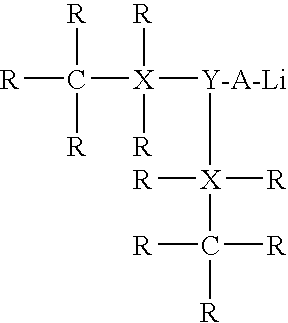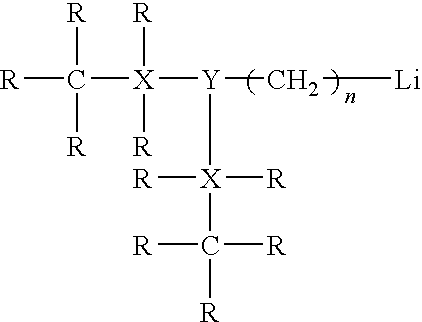Potassium based catalyst systems for synthesizing rubbery polymers
a catalyst system and catalyst technology, applied in the direction of tyre parts, vehicle components, chemical/physical processes, etc., can solve the problems of difficult to improve the wear characteristics of tires without sacrificing wet skid resistance and traction characteristics, and achieve the effect of desirabl
- Summary
- Abstract
- Description
- Claims
- Application Information
AI Technical Summary
Benefits of technology
Problems solved by technology
Method used
Image
Examples
example 1
[0050]In this experiment, 2000 g of a hexane premix containing about 20% monomer(s) consisting of 10% styrene and 90% butadiene was charged to a one gallon stainless steel reactor with an air-driven motor, a nitrogen inlet for providing an inert nitrogen atmosphere, and internal heating / cooling coils for temperature regulation. The catalyst system, which included potassium triethylborohydride and n-butyl lithium, was added to the premix in a ratio of 0.25 mmol of catalyst per 100 g of the monomer mixture. The molar ratio of potassium triethylborohydride to n-butyl lithium was 1:1.
[0051]The polymerization was carried out at 90° C. and the reaction monitored using gas chromatography (“GC”) to detect for the presence of unreacted monomers. After 25 minutes, 98% conversion of the monomers was realized. After polymerization was completed, ethanol was added to shortstop the polymerization. The polymer cement was then removed from the reactor and stabilized with antioxidant. After evaporat...
examples 2-5
[0052]For Examples 2-5, the same procedure and catalyst materials were utilized as in Example 1, except the catalyst concentration and ratios were varied to determine the effect on molecular weight. The ratio of styrene to butadiene was varied as well. The rubbery polymers similarly were characterized using, for example, differential scanning calorimetry (DSC) and nuclear magnetic resonance (NMR). Examples 2-5, along with their results, are also set out in Table 1.
[0053]
TABLE 1Example12345Styrene / butadiene10 / 9015 / 7520 / 8025 / 7530 / 70ratioGlass transition−85° C.−82° C.−77° C.−75° C.−71° C.temperature (Tg ° C.)Catalyst0.25 mmole0.33 mmole0.15 mmole0.25 mmole0.40 mmoleConcentration(per 100 g monomermixture)Number avg.250,000225,000300,000250,000200,000molecular weight(Mn)Weight avg.300,000325,000400,000525,000230,000molecular weight(Mw)Vinyl 1,2 content1414181720(%)1,4-trans content5651494952(%)1,4-Cis content (%)3035333428ML4 @ 100° C.6677878875Short StopIsopropanolIsopropanolIsopropanol...
example 6
[0054]In this experiment, 2000 g of a hexane premix containing about 20% monomer(s) consisting of 10% styrene and 90% butadiene was charged to a one gallon stainless steel reactor with an air-driven motor, a nitrogen inlet for providing an inert nitrogen atmosphere, and internal heating / cooling coils for temperature regulation. The catalyst system, which included potassium triethylaluminumhydride and n-butyl lithium, was added to the premix in a ratio of 0.25 mmol of catalyst per 100 g of the monomer mixture. The molar ratio of potassium triethylaluminumhydride to n-butyl lithium was 1:1.
[0055]The polymerization was carried out at 90° C. and the reaction monitored using gas chromatography (“GC”) to detect for the presence of unreacted monomers. After 25 minutes, 98% conversion of the monomers was realized. After polymerization was completed, ethanol was added to shortstop the polymerization. The polymer cement was then removed from the reactor and stabilized with antioxidant. After ...
PUM
| Property | Measurement | Unit |
|---|---|---|
| weight percent | aaaaa | aaaaa |
| weight percent | aaaaa | aaaaa |
| weight percent | aaaaa | aaaaa |
Abstract
Description
Claims
Application Information
 Login to View More
Login to View More - R&D
- Intellectual Property
- Life Sciences
- Materials
- Tech Scout
- Unparalleled Data Quality
- Higher Quality Content
- 60% Fewer Hallucinations
Browse by: Latest US Patents, China's latest patents, Technical Efficacy Thesaurus, Application Domain, Technology Topic, Popular Technical Reports.
© 2025 PatSnap. All rights reserved.Legal|Privacy policy|Modern Slavery Act Transparency Statement|Sitemap|About US| Contact US: help@patsnap.com


